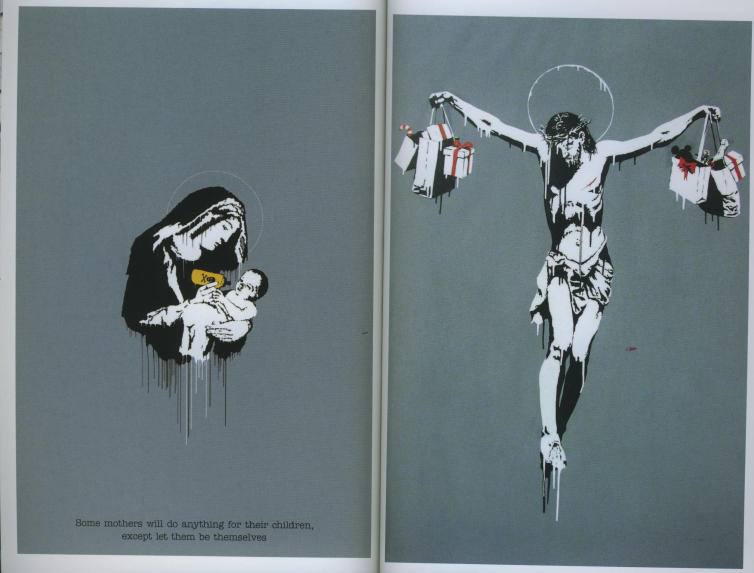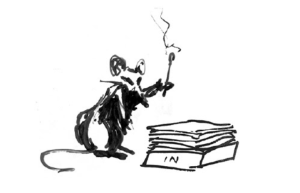
‘A poignant and insightful picture that powerfully critiques organized religion,
and no-one wants to buy. Absolutely nobody.’
Toxic Mary portrays Virgin Mary, cloaked in drapery, feeding her infant, in the style of a classic Renaissance painting. However, in this version, her baby is fed with a bottle marked with a skull and crossbones as if it were poison. Unlike Banksy’s usual clean style, paint drips are running across the image, just as if the scene was melting before our eyes, evoking a sense of despair.
‘Some mothers will do anything for their children, except let them be themselves.’

Banksy portrays religion as a toxic ideology passed from parents to children. More widely, the artist comments on the general toxicity of family relationships, in which outdated ideas and traditions repeat themselves. It may well also illustrate how our societies promote Big Pharma baby formula over natural breast milk. Indeed, as it is always the case with Banksy, there are a few different readings to his art. The label on the milk bottle clearly targets pharmaceutical companies that produce formula milk for babies. The mother willingly uses what she thinks is best for her baby, because she has been assured this is the right thing to do…


The figure of the Madonna is one of the most easily recognizable, most frequently produced images in the history of art. The word Madonna is derived from the Italian ‘ma donna,’ or ‘my lady’ and is used to describe Mary, the mother of Christ. The most well-known examples of The Madonna and Child were completed by Italian painter Raphael, who moved from his native Urbino to Florence at the turn of the 16th century. Over the course of his career, the artist created more than 30 paintings of The Madonna and Child, for devotional panels and commercial sales, as well as gifts for friends, including one wedding present. His representations are considered among the most reverential and graceful of Mary and Jesus.
 RAPHAEL
RAPHAELMadonna and Child, c. 1506-1507
Oil on yew wood, 27.9 x 22.4 cm
The National Gallery, London
Banksy also created a few originals based on this provoking visual.
Toxic Mary, 2003
Estimated: GBP 400,000 – 600,000
GBP 455,250

Toxic Mary, 2003
180×188 cm (74 x 70 3/4 inches)

Enamel and emulsion on cardboard
200.4 x 170.2 cm (79×67 inches)
Christie’s London, 26 June 2019
GBP 419,250
DESCRIPTION
Toxic Mary
Editions
Unsigned Edition:600
Numbering and Signature Placement
With or without the publisher’s blindstamp
COLORWAYS
Edition: 44 signed
AUCTION RESULTS
FOR A DETAILED ANALYSIS OF AUCTION RESULTS
PLEASE CHECK BANKSY VALUE: EARLY PRINTS
YOU WILL ONLY FIND THE MOST RECENT AUCTION RESULTS BELOW
Toxic Mary (unsigned) sold twice at auction in 2025 so far.
Tate Ward Auctions: 19 March 2025
Estimated: GBP 8,000 – 10,000
GBP 10,625 / USD 13,695

BANKSY (British 1974-)
‘Toxic Mary’ (unsigned), 2004
Screenprint in colors on wove paper
Numbered 586/600 in pencil
Forum Auctions: 5 March 2025
Estimated: GBP 10,000 – 15,000
GBP 10,000 (Hammer)
GBP 13,120 / USD 16,910

BANKSY (b.1974)
Toxic Mary (unsigned), 2003
Screenprint in colors on wove paper
Numbered from the edition of 600 in pencil with the publisher’s blindstamp
Toxic Mary (signed) sold once at auction in 2025 so far.
Christie’s online: 1 April 2025
Estimated: GBP 18,000 – 25,000
GBP 35,280 / USD 45,582

BANKSY
Toxic Mary (signed), 2003-2004
Screenprint in colors on wove paper
Signed, dated 04 and inscribed with a heart in pencil
Outside of the Edition (aside from the signed edition of 150) with the publisher’s blindstamp







